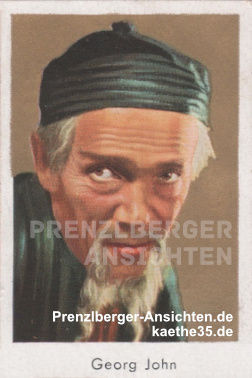JEWISH LIFE IN PRENZLAUER BERG, PART 3
Isidor Lewy & Georg John
The house at Lippehner Str. 35 (since 1974: Käthe-Niederkirchner-Str.) in the Bötzowkiez was a so-called "Jews House" during the Nazi dictatorship. Simon Lütgemeyer has lived there since the late 1990s and has done intensive research on the history of the house's residents.
Master mason Herrmann Knoll built the house Lippehner Str. 35 in the new Bötzowviertel in 1903 and sold it to the textile manufacturer Isidor Lewy, who also lived there with his family in the front house 2nd floor.
Lewy died in 1936. His widow Lina was forced to sell the house in 1939 and died in 1942 shortly after her deportation to the Theresienstadt ghetto. In 1939, being "head of household", she had entered the name Georg Jacobsohn on a census form, as a flatmate in addition to her daughters and grandsons.
He was the son of Isidor Lewy's sister Ernestine, and long before 1939 he was not unknown as the actor Georg John.
Georg John
Born in Schmiegel near Posen on July 23, 1879, he began his career on stages in various cities until he worked as an actor and director in Vienna from 1914.
From 1916 to 1933, he not only appeared in over 90 German film productions, but also played important supporting roles in outstanding films of the silent era and in later sound films, including Dr. Mabuse (1922/33), Die Nibelungen (1924), Metropolis (1927), M (1931) and finally Sprung in den Abgrund (Jump Into The Abyss, 1933).
Even in his first film roles, John embodied the characters that were becoming typical of him: "wrinkled gnomes and strangely whimsical old men - films in which the actor usually looked considerably older than he actually was" (Kay Weniger: The Great Lexicon of Film Persons).

He can be seen as a night watchman in Der letzte Mann (The Last Man, 1924) alongside Emil Jannings, in M alongside Peter Lorre as a blind balloon salesman who identifies the murderer by the whistled melody, or in F.P.1 antwortet nicht (F.P.1 Doesn’t Answer, 1932) as a machinist alongside Hans Albers.
John is cast by almost all the renowned directors of the time, often Fritz Lang, but also F. W. Murnau, Joe May, Richard Oswald, Harry Piel, Paul Leni and others.
Classified as a "full Jew" by the Nazi system, after the seizure of power Georg John was immediately excluded from the German cultural scene and was also no longer offered film roles from the spring of 1933. He then joins the Jewish Cultural Association under his birth name - Jews are forbidden to continue using stage names - and takes part in its performances until the dissolution of the institution on September 11, 1941 (last appearance in Franz Molnar's Spiel im Schloss (Play in the Castle) in August 1941).
On October 29, 1941, Georg John is the first of many other residents of the house to be deported on the "III rd Transport" from Grunewald Station to the Litzmannstadt Ghetto (Łódź), where he dies after a few days on November 18.
His brother Johannes who is 10 years younger (stage name Hanns John, Chasan and singer, his voice is preserved on record), is registered living with Betty Lewy, a niece of Isidor Lewy, at Bötzowstr. 28, when he, like Daniel Baruch from Lippehner Str. 35, is taken to Sachsenhausen on May 27 1942 and shot as part of a "retaliation action".
Simon Lütgemeyer / M. Steinbach (Dec. 2021)
Source: Documentation "Käthe 35

